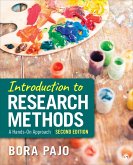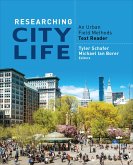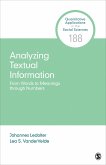- Broschiertes Buch
- Merkliste
- Auf die Merkliste
- Bewerten Bewerten
- Teilen
- Produkt teilen
- Produkterinnerung
- Produkterinnerung
This text helps students learn how to select, read, understand, and evaluate the research they read. Many texts focus on the process of conducting research and not as much on how students in applied disciplines can assess and apply that research in their future professional lives; this text aims to fill that gap.
Andere Kunden interessierten sich auch für
![Introduction to Research Methods Introduction to Research Methods]() Bora PajoIntroduction to Research Methods153,99 €
Bora PajoIntroduction to Research Methods153,99 €![Completing Your Qualitative Dissertation Completing Your Qualitative Dissertation]() Linda Dale BloombergCompleting Your Qualitative Dissertation114,99 €
Linda Dale BloombergCompleting Your Qualitative Dissertation114,99 €![Developing Theory Through Qualitative Inquiry Developing Theory Through Qualitative Inquiry]() Johnny SaldanaDeveloping Theory Through Qualitative Inquiry62,99 €
Johnny SaldanaDeveloping Theory Through Qualitative Inquiry62,99 €![Leading Change Through Evaluation Leading Change Through Evaluation]() Kristen L. RohannaLeading Change Through Evaluation39,99 €
Kristen L. RohannaLeading Change Through Evaluation39,99 €![Rasch Models for Solving Measurement Problems Rasch Models for Solving Measurement Problems]() Engelhard, George, Jr.Rasch Models for Solving Measurement Problems39,99 €
Engelhard, George, Jr.Rasch Models for Solving Measurement Problems39,99 €![Researching City Life Researching City Life]() Researching City Life118,99 €
Researching City Life118,99 €![Analyzing Textual Information Analyzing Textual Information]() Johannes LedolterAnalyzing Textual Information48,99 €
Johannes LedolterAnalyzing Textual Information48,99 €-
-
-
This text helps students learn how to select, read, understand, and evaluate the research they read. Many texts focus on the process of conducting research and not as much on how students in applied disciplines can assess and apply that research in their future professional lives; this text aims to fill that gap.
Produktdetails
- Produktdetails
- Verlag: SAGE Publications Inc
- Seitenzahl: 264
- Erscheinungstermin: 6. Juli 2023
- Englisch
- Abmessung: 228mm x 148mm x 14mm
- Gewicht: 382g
- ISBN-13: 9781544361482
- ISBN-10: 1544361483
- Artikelnr.: 67483822
- Herstellerkennzeichnung
- Libri GmbH
- Europaallee 1
- 36244 Bad Hersfeld
- gpsr@libri.de
- Verlag: SAGE Publications Inc
- Seitenzahl: 264
- Erscheinungstermin: 6. Juli 2023
- Englisch
- Abmessung: 228mm x 148mm x 14mm
- Gewicht: 382g
- ISBN-13: 9781544361482
- ISBN-10: 1544361483
- Artikelnr.: 67483822
- Herstellerkennzeichnung
- Libri GmbH
- Europaallee 1
- 36244 Bad Hersfeld
- gpsr@libri.de
Paul A. Schutz, PhD is currently a Professor in the Department of Educational Psychology at the University of Texas at San Antonio. His research interests include the nature of emotion, the influence of emotional experiences on teachers' identity development, research methods and issues related to race and social justice. He has several publications related to the use of mixed methods and has taught a variety of different research methods course, including qualitative, quantitative and mixed methods research courses. He is a past president for Division 15: Educational Psychology of the American Psychological Association and a former co-editor of the Educational Researcher: Research News and Comment, a lead journal for the American Educational Research Association.
Chapter 1: Introduction and Overview
Organizing Terms and Concepts
Why Scientific Literacy Is Important
Nature of Data-Driven Research: Introduction to Research Methods
Conclusion
Chapter 2: Introduction and Overview of Data-Driven Articles
Searching for Scientific Evidence
How to Cull Through Data-Driven Articles
Sections of Data-Driven Articles
Results
Conclusion
Chapter 3: Literature Review
What Is Involved in the Construction of a Useful Literature Review?
What Are Some of the Potential Goals of a Literature Review?
What Is in the Literature Review?
Conclusion
Chapter 4: Methods and Results: Quantitative Approaches
Overview
Quantitative Methods
Putting It All Together
Chapter 5: Methods and Results: Qualitative Approaches
Overview
Qualitative Methods
Looking Out for Rigor
Putting It All Together
Chapter 6: Methods and Results: Mixed Methods Approaches
Overview
What Are Some Benefits Associated With Mixed Method Research?
What Are Some Purposes of Mixed Method Research?
Integration in Mixed Methods Research
Looking Out for Rigor
Chapter 7: Putting it All Together - Discussion, Conclusions, and
Implications
Overview
Ending a Research Article
Putting It All Together-Reading and Evaluating Research From Start to
Finish
Organizing Terms and Concepts
Why Scientific Literacy Is Important
Nature of Data-Driven Research: Introduction to Research Methods
Conclusion
Chapter 2: Introduction and Overview of Data-Driven Articles
Searching for Scientific Evidence
How to Cull Through Data-Driven Articles
Sections of Data-Driven Articles
Results
Conclusion
Chapter 3: Literature Review
What Is Involved in the Construction of a Useful Literature Review?
What Are Some of the Potential Goals of a Literature Review?
What Is in the Literature Review?
Conclusion
Chapter 4: Methods and Results: Quantitative Approaches
Overview
Quantitative Methods
Putting It All Together
Chapter 5: Methods and Results: Qualitative Approaches
Overview
Qualitative Methods
Looking Out for Rigor
Putting It All Together
Chapter 6: Methods and Results: Mixed Methods Approaches
Overview
What Are Some Benefits Associated With Mixed Method Research?
What Are Some Purposes of Mixed Method Research?
Integration in Mixed Methods Research
Looking Out for Rigor
Chapter 7: Putting it All Together - Discussion, Conclusions, and
Implications
Overview
Ending a Research Article
Putting It All Together-Reading and Evaluating Research From Start to
Finish
Chapter 1: Introduction and Overview
Organizing Terms and Concepts
Why Scientific Literacy Is Important
Nature of Data-Driven Research: Introduction to Research Methods
Conclusion
Chapter 2: Introduction and Overview of Data-Driven Articles
Searching for Scientific Evidence
How to Cull Through Data-Driven Articles
Sections of Data-Driven Articles
Results
Conclusion
Chapter 3: Literature Review
What Is Involved in the Construction of a Useful Literature Review?
What Are Some of the Potential Goals of a Literature Review?
What Is in the Literature Review?
Conclusion
Chapter 4: Methods and Results: Quantitative Approaches
Overview
Quantitative Methods
Putting It All Together
Chapter 5: Methods and Results: Qualitative Approaches
Overview
Qualitative Methods
Looking Out for Rigor
Putting It All Together
Chapter 6: Methods and Results: Mixed Methods Approaches
Overview
What Are Some Benefits Associated With Mixed Method Research?
What Are Some Purposes of Mixed Method Research?
Integration in Mixed Methods Research
Looking Out for Rigor
Chapter 7: Putting it All Together - Discussion, Conclusions, and
Implications
Overview
Ending a Research Article
Putting It All Together-Reading and Evaluating Research From Start to
Finish
Organizing Terms and Concepts
Why Scientific Literacy Is Important
Nature of Data-Driven Research: Introduction to Research Methods
Conclusion
Chapter 2: Introduction and Overview of Data-Driven Articles
Searching for Scientific Evidence
How to Cull Through Data-Driven Articles
Sections of Data-Driven Articles
Results
Conclusion
Chapter 3: Literature Review
What Is Involved in the Construction of a Useful Literature Review?
What Are Some of the Potential Goals of a Literature Review?
What Is in the Literature Review?
Conclusion
Chapter 4: Methods and Results: Quantitative Approaches
Overview
Quantitative Methods
Putting It All Together
Chapter 5: Methods and Results: Qualitative Approaches
Overview
Qualitative Methods
Looking Out for Rigor
Putting It All Together
Chapter 6: Methods and Results: Mixed Methods Approaches
Overview
What Are Some Benefits Associated With Mixed Method Research?
What Are Some Purposes of Mixed Method Research?
Integration in Mixed Methods Research
Looking Out for Rigor
Chapter 7: Putting it All Together - Discussion, Conclusions, and
Implications
Overview
Ending a Research Article
Putting It All Together-Reading and Evaluating Research From Start to
Finish








